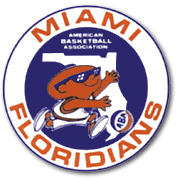
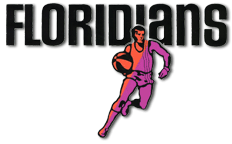

   |
Miami Floridians/The Floridians2012 NBA/ABA Throwback Uniforms -
|
Back to "Remember the ABA" Main Page
Did you see an ABA Floridians game? Or, did you have a favorite Floridians player? Contribute to this web page by
(portions from Jim Grasso and the December 1974 ABA Fan Club Newsletter -- used with permission)
The Floridians existed for only four ABA seasons (from 1968-69 through 1971-72). They moved to Miami from Minnesota (where they were the Muskies in 1967-68), and stayed in Florida until they folded in May 1972. Why were they called simply "The Floridians"? Because during the later years of their existence, the team played games all over Florida. Most games were in Miami, some were in Tampa/St. Pete and Jacksonville, and a small number were in West Palm Beach.
What do Floridians fans remember about their team? The Floridians were renowned for their scantily clad ballgirls and crazy promotions. Research for the 1997 HBO documentary on the ABA turned up some Floridians video footage. Predictably, almost all of the footage showed the ballgirls.
On October 31, 1970, the Floridians home program advertised the team's next two home games. It didn't even mention the two ABA teams the Floridians were going to play. Instead, the program stated: "FREE PANTYHOSE--The Floridians return to the Convention Hall Thursday, Nov. 5, for Ladies Night, with pantyhose given away to the first 500 ladies through the turnstiles. The pantyhose are a regular $2 value, honey in color and sheer, stretch nylon that fit any size of women five-feet to five-feet, nine inches tall. Nothing extra to buy, women don't even need reserved seats. There are also other special surprises for the ladies. But come early. The next home game is -- Tuesday Nov. 10 : a basketball-boxing doubleheader. Buy a $5 ticket which allows you to walk to the adjacent Auditorium to see heavyweight Jimmy Ellis' first fight since his loss to Joe Frazier. It's a unique basketball-boxing doubleheader! The Ellis fight doesn't begin until the game ends."
Other Floridians promotions included these creative giveaways: live turkeys for Thanksgiving, 15 pounds of smoked fish (to one lucky fan!), 57 pounds of Irish potatoes (on "Irish Night," also to one lucky fan), 53 pumpkin pies, vats of gefilte fish, kegs of beer, ice cream, and ABA balls.
The history of the Floridians began, curiously, in wintery Bloomington, Minnesota. During the ABA's inaugural season (1967-68), Larry Shields' Minnesota Muskies were a bust at the box office, despite a 50-28 record. Shields found the allure of glittering Miami irresistible and, getting a small group of Florida businessmen to buy shares of the franchise, moved it south. Before leaving Minnesota, Shields made what must be the worst deal in ABA history: the trade of Rookie-of-the-Year Mel Daniels to the Indiana Pacers for $100,000, a draft choice, and two warm bodies. Shields needed the money to pay his Minnesota debts. If he could have afforded to keep Daniels, the Floridian story may have had a more happy ending.
The Floridians' first homes were the Miami Beach Convention Center and the Convention Center Annex. For trivia buffs, the team colors were orange, blue and white. Jim Pollard coached the team to a strong second place finish in its first season (1968-69), with Skip Thoren taking over the pivot from Mel Daniels, and Donnie Freeman and Les (Big Game) Hunter providing the firepower. In the first round of the 1969 ABA Playoffs, Miami eliminated the Minnesota Pipers (the defending ABA Champions), four games to three. Game 7 of this series took place in Miami, where a rare large crowd helped the Floridians to a series-clinching victory over Connie Hawkins and the Pipers. However, the Pacers (led by Daniels) won the Eastern Division Finals over Miami four games to one.
Attendance, although better than in Minnesota, was still very poor. Part of the problem was that the Floridians played in Miami Beach while most of their potential fans lived on the mainland. Also, at the time, Miami was not exactly a "basketball hotbed" (despite the collegiate exploits of Rick Barry at the University of Miami).
The next year (1969-70), the Floridians' home areas were, believe it or not, an ex-aircraft hangar (Dinner Key Auditorium) and a junior college gym. The Florida investors, led by Dr. Thomas Carney, took over more of the direction of the franchise. Miami signed one of the NBA's #1 draft choices, Larry Cannon of LaSalle, and small college rebounding champ Wil Jones. In an effort to appeal to Miami's Cuban-Americans, the Floridians also signed rookie Al Cueto. Early in the season, center Skip Thoren ruined his knee -- ending a promising career. The Floridians' new coach, Hal Blitman, in converting Cannon into a guard, tried to bring him along slowly. But the temperamental rookie stormed out of the arena in the middle of a game because of a lack of playing time, threatening to jump the team. Blitman and Cannon eventually patched things up, but the team sputtered along. The direction of the franchise became extremely confused, with trades being made by the owners without Blitman's or the general manager's knowledge. The Floridians ended the 1969-70 season in last place. Donnie Freeman, one of the finest guards ever to dribble the multicolored basketball, averaged 27.4 ppg -- tops on the team. For what likely was an ABA record, 22 different players wore the Miami orange, blue and white that season.
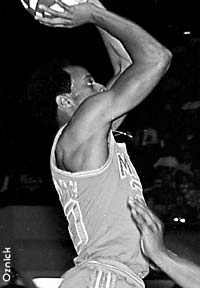 |
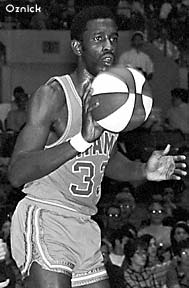 |
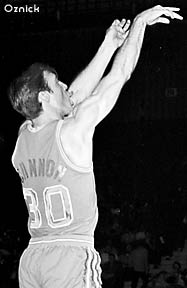 |
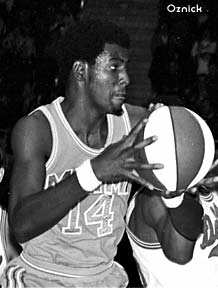 |
During the 1969-70 season, the Miami Floridians stumbled to incredible lows. During the two previous seasons, the franchise was among the best in the ABA. But in 1969-70, Miami had a 23-61 record, the worst in all of professional basketball. Amazingly, 22 (that's right, 22) different players wore a Floridians uniform that season.
Don Freeman (above left, #20) delivered despite the team's struggles, averaging an impressive 27.4 ppg. Don Sidle (above middle, #33) also managed to salvage a strong season, averaging 20.8 ppg. Heralded rookie Larry Cannon (above right, #30) had a rough adjustment to the pros. He feuded with Miami Coach Hal Blitman and enjoyed better seasons later in his ABA career with the Denver Rockets and Indiana Pacers. Another Miami rookie standout was 6-8 forward Wil Jones (#14, left). In his first year in the ABA, Jones was still learning how to score. From day one, though, he could rebound. In 1969-70 he scored only 8.2 ppg, but averaged a very strong 7.6 rebounds per contest. In the midst of Miami's 1969-70 mess no one could foresee that Jones would become one of the ABA's most rugged defenders. He played 6 more ABA seasons and eventually anchored the defense of the 1974-75 ABA Champion Kentucky Colonels. Following the merger in 1976, Jones played two additional seasons in the NBA (for the Pacers and the Buffalo Braves). Photos Copyright © John Oznick and used with permission. |
The original Miami owners wanted out; they had lost a lot of money over two seasons. In stepped Ned Doyle, a retired advertising executive (best known in the ad world for his imaginative Volkswagen ads) to buy the team. Doyle, in effect, fired the team but kept the coach -- a rather novel approach. He also dropped "Miami" from the team name and the franchise went "regional," playing its home games in Miami Beach (back in the Convention Center), Jacksonville, Tampa/St. Pete and West Palm Beach. The team colors were changed to magenta, orange and black. Ball girls, wearing skimpy bikinis, were hired. General Manager Dennis Murphy, spending plenty of Doyle's money, acquired Mack Calvin, Larry Jones, Tom "Trooper" Washington, and Ron Franz.
During the 1970-71 season, Calvin was a first-team ABA All-Star selection and averaged 27.2 ppg. Alongside Calvin, Jones scored at a 24.3 ppg clip. According to the Floridians' media guide, these two created the highest scoring guard combination in the history of professional basketball. In December of 1970, the Floridians obtained 6'9" ABA veteran Ira Harge. Harge played some of the best basketball of his career down the stretch of the 1970-71 season, averaging 15.4 ppg and 14.1 rpg with the Floridians. Harge's presence took the pressure off of Calvin and Jones, and allowed the team to make a late season playoff drive. Bob Bass assumed the coaching reigns from Hal Blitman on January 15, 1971. At that time, the Floridians were stuck in last place in the Eastern Division. After Bass took over, the team won 19 of its final 36 games, including seven crucial contests in a row, to pass Carolina and Pittsburgh for a playoff berth. In the first round of the 1971 Playoffs, the frenetic offensive attack of Calvin and Jones confused a powerful Kentucky team, and the Floridians extended the eventual runner-up Colonels to a six game series.
Doyle was determined to give it one more try. For 1971-72, the "regional franchise" setup was largely dropped (34 of the team's home games were scheduled for Miami, and only 7 were scheduled for Tampa/St. Pete). Also, the Floridians acquired Warren Jabali and Manny Leaks for added firepower. Bass' team played scrappy ball, and the Floridians were fun to watch. In particular, Jabali had one of his very best pro seasons. He scored 19.9 points per game, dished out 6.2 assists per game, and grabbed 8.2 rebounds per game (playing an average of 40.2 minutes per contest). Jabali also hit 102 out of 285 three-pointers for an impressive .358 percentage (good for 3rd in the ABA behind Glen Combs of Utah and Louie Dampier of Kentucky). He made the East squad in the 1972 ABA All-Star Game and won about 10 games for the Floridians with heroic performances in closing minutes.
Calvin remained the team's high scorer, averaging 21 points per game and hitting 87% from the free throw line (2nd in the league behind Rick Barry). Jones also had a nice year, averaging 17.6 points per game, and finishing 5th in the entire league with a 53.1% two-point field goal percentage. Unfortunately, Jones suffered a broken hand in the middle of the season and missed 19 straight games. The Floridians went 4-15 during that stretch (in contrast to a 32-33 record WITH Jones in the lineup). Leaks left the team late in the season after a salary dispute, leaving the Floridians with a serious void on defense, especially in the middle. With their frenetic offensive attack offset by ineffective team defense, the Floridians limped to a 36-48 record -- good for fourth place in the Eastern Division and a playoff spot. In the first round of the ABA Playoffs, the Floridians bowed out in four straight to rookie phenom Julius Erving and the Virginia Squires. During the course of that series, Erving had three games of over thirty rebounds and completely overwhelmed the Floridians.
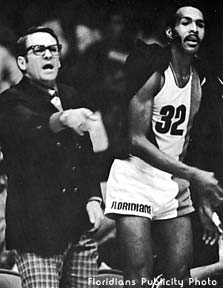 |
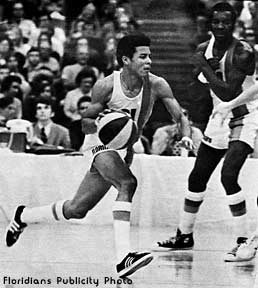 |
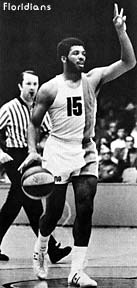 |
The 1971-72 Floridians were entertaining in a number of different ways. To say the least, the ballgirls were memorable, and the prize giveaways to fans were . . . unusual. But, for those fans who actually showed up at the Miami Beach Convention Hall to cheer the team, the Floridians were a lot of fun to watch. Coach Bob Bass (above left) directed a relentless run-and-gun attack using the potent guard combination of Larry Jones (above left, #32) and Mack Calvin (above right). While Jones was slowed by a broken hand that season, the Floridians also had Warren Jabali, another of the ABA's best guards. Jabali, acquired from the Pacers prior to the 71-72 season, had a great season. Jabali quarterbacked the Floridians to their third playoff appearance in four years. The only problem? Dr. J and the Virginia Squires, their first round playoff opponent. Erving and the Squires dispatched the Floridians in four quick games. Game 4, played at Miami Dade Community College (North Campus) turned out to be the last ever Floridians game. In 1997, Jones, Calvin and Jabali were each named to the 30-man All-Time ABA Team. |
Ballgirls and bikinis aside, the Floridians were unable to dent the indifference to pro basketball in south Florida. The two home playoff games against Virginia drew only 2,965 and 3,126 fans and even the perennially optimistic Doyle saw the futility of continuing. All that remained was for Doyle to disband the franchise. The players were dispersed to other ABA teams and the Floridians became a memory -- a nice try -- a monument to optimism and dogged persistence.
Floridians 1968-69 Home Uniform |
Floridians 1969-70 Road Uniform |
Floridians 1970-72 Home Uniform |
Floridians 1970-72 Road Uniform |
1968-69 Season (known as Miami Floridians)
Record: 43-35, Second Place in Eastern Division
1969 Playoff Results:Eastern Division Semifinals vs. Minnesota Pipers (36-42)
Floridians won series, 4-3Eastern Division Finals vs. Indiana Pacers (44-34)
Pacers won series, 4-1
Record: 23-61, Sixth Place in Eastern Division
Missed Playoffs
Record: 37-47, Fourth Place in Eastern Division
1971 Playoff Results:Eastern Division Semifinals vs. Kentucky Colonels (44-40)
Colonels won series, 4-2
Record: 36-48, Fourth Place in Eastern Division
1972 Playoff Results:Eastern Division Semifinals vs. Virginia Squires (45-39)
Squires won series, 4-0